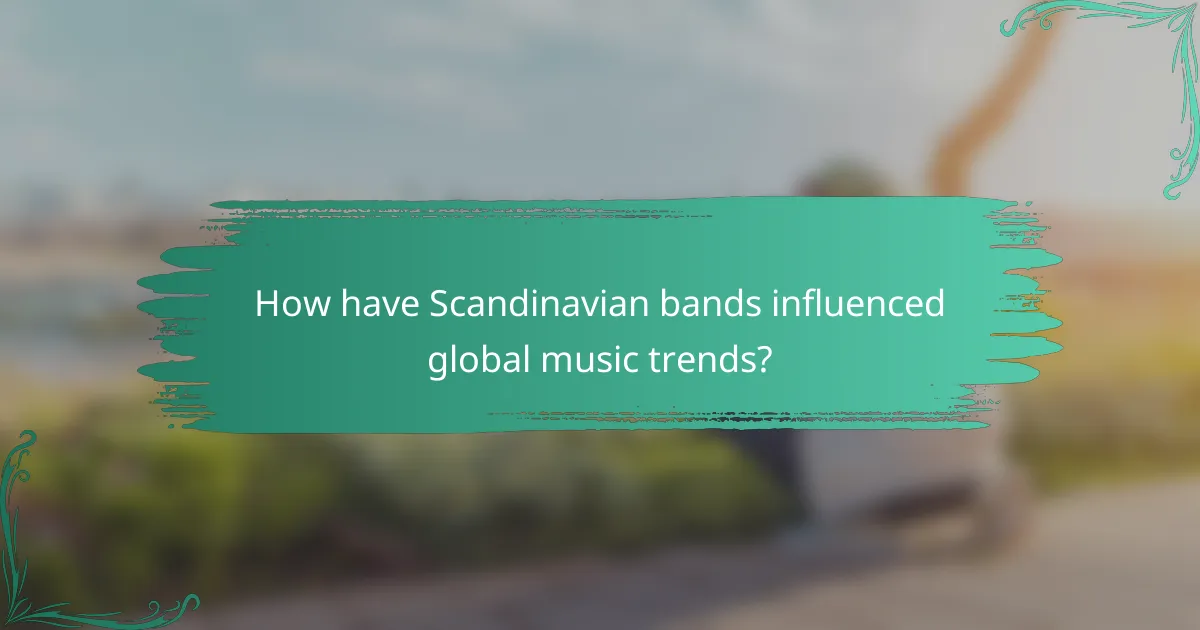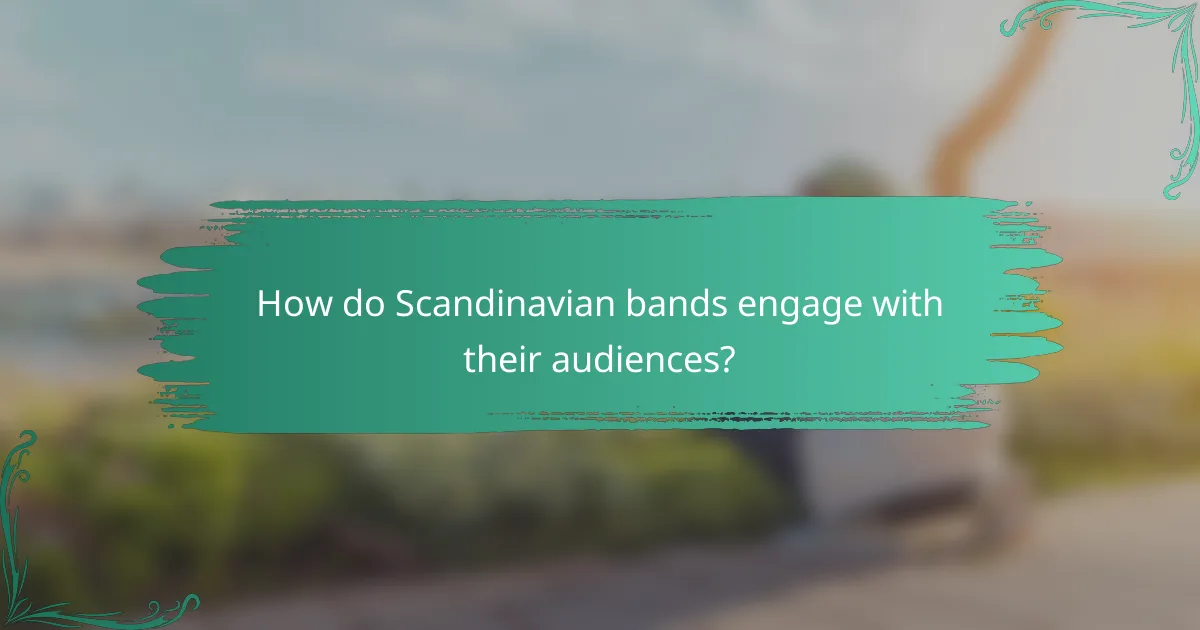Scandinavian bands have played a pivotal role in shaping global music trends, offering innovative sounds across various genres such as pop, metal, jazz, and electronic music. With iconic groups like ABBA and Ghost leading the charge, the region’s music scene is characterized by a dynamic blend of emerging indie artists and established acts, reflecting a rich cultural landscape that resonates worldwide.

How have Scandinavian bands influenced global music trends?
Scandinavian bands have significantly shaped global music trends through their innovative sounds and diverse genres. Their influence spans pop, metal, jazz, and electronic music, creating a rich tapestry that resonates worldwide.
Impact of ABBA on pop music
ABBA’s impact on pop music is profound, with their catchy melodies and harmonies setting a standard for pop groups globally. Their success in the 1970s and 1980s established a template for pop songwriting that many artists still follow today.
Their songs, characterized by strong hooks and relatable themes, have influenced countless artists across generations, from the 1990s boy bands to contemporary pop stars. ABBA’s music remains a staple in popular culture, showcasing the enduring appeal of their sound.
Nordic jazz and its global reach
Nordic jazz has gained international acclaim, known for its unique blend of traditional jazz elements with influences from folk music and modern sounds. Artists from Sweden, Norway, and Denmark have introduced innovative approaches that challenge conventional jazz norms.
Notable musicians like Esbjörn Svensson and Nils Frahm have expanded the genre’s boundaries, attracting audiences worldwide. Festivals and collaborations have further propelled Nordic jazz onto the global stage, highlighting its versatility and creativity.
Influence of Scandinavian metal on rock genres
Scandinavian metal has left a significant mark on rock genres, particularly through the development of subgenres like black metal and melodic death metal. Bands such as Metallica and Opeth have drawn inspiration from the raw energy and intricate compositions of Scandinavian groups.
The region’s metal scene is characterized by its theatrical elements and lyrical depth, often exploring themes of mythology and nature. This distinctive style has influenced numerous international bands, contributing to the global popularity of metal music.
Role of electronic music from Sweden
Sweden is a powerhouse in electronic music, with artists like Avicii and Robyn leading the charge in blending pop with electronic elements. Their innovative production techniques and catchy beats have set trends that resonate across the globe.
The Swedish music scene has fostered a collaborative environment, allowing for cross-genre experimentation that has elevated electronic music’s status. This influence is evident in the charts, where Swedish producers frequently dominate with their infectious tracks.
Folk music revival in contemporary scenes
The revival of folk music in Scandinavia has brought traditional sounds to contemporary audiences, blending old and new influences. Artists like First Aid Kit and Of Monsters and Men have reinterpreted folk traditions, making them accessible to a modern listener.
This resurgence has sparked interest in folk instruments and storytelling, leading to a renewed appreciation for cultural heritage. Festivals celebrating folk music have emerged, showcasing both established and emerging artists, further solidifying the genre’s place in today’s music landscape.

What are the most popular Scandinavian bands today?
Today, some of the most popular Scandinavian bands include ABBA, Ghost, Roxette, and First Aid Kit. These groups have made significant impacts in their respective genres and continue to influence music both locally and globally.
ABBA’s resurgence in modern culture
ABBA has experienced a notable resurgence in modern culture, largely driven by the success of the musical “Mamma Mia!” and its film adaptations. Their classic hits have been reimagined in various formats, including remixes and covers, appealing to both old fans and new listeners.
Their music’s timeless quality, combined with nostalgia, has led to a revival in popularity, with ABBA’s recent album “Voyage” further cementing their status in the contemporary music scene. This renewed interest showcases how classic bands can adapt and thrive in today’s market.
Rising popularity of Ghost in metal
Ghost, a Swedish rock band, has gained significant traction in the metal genre, known for their theatrical performances and unique sound. Their blend of heavy metal with melodic elements has attracted a diverse audience, making them a standout act in the global music landscape.
Their albums consistently chart well, and they have garnered a dedicated fan base, leading to sold-out shows worldwide. Ghost’s ability to combine catchy melodies with darker themes resonates with many listeners, contributing to their rising popularity.
Impact of Roxette on international charts
Roxette, a duo from Sweden, has had a lasting impact on international charts since the late 1980s. Their catchy pop-rock sound produced numerous hits that topped charts in multiple countries, including the US and UK.
Even today, their songs like “It Must Have Been Love” and “Listen to Your Heart” remain popular, often featured in films and covered by various artists. Roxette’s ability to craft memorable melodies has solidified their legacy in the music industry.
Significance of First Aid Kit in folk music
First Aid Kit, a Swedish folk duo, has made significant contributions to the folk music genre with their harmonious vocals and poignant lyrics. Their authentic sound and storytelling ability resonate deeply with audiences, earning them critical acclaim and a loyal following.
Their albums often explore themes of love, loss, and identity, drawing inspiration from both traditional and contemporary folk influences. First Aid Kit’s success highlights the growing appreciation for folk music in a modern context, bridging cultural gaps and appealing to diverse listeners.

What trends are shaping the Scandinavian music scene?
The Scandinavian music scene is currently influenced by a blend of emerging indie bands, a booming pop music industry, cross-genre collaborations, and the integration of advanced technology in music production. These trends reflect a vibrant cultural landscape that continues to evolve and reach global audiences.
Emergence of indie bands in Norway
Norway has seen a significant rise in indie bands, characterized by their unique sound and DIY approach to music production. Artists often blend various genres, creating a distinct musical identity that resonates with both local and international listeners.
Notable indie bands like Kakkmaddafakka and Highasakite have gained popularity through grassroots efforts, including local performances and social media engagement. This trend emphasizes authenticity and artistic freedom, allowing musicians to connect deeply with their audience.
Growth of pop music in Denmark
Denmark’s pop music scene has experienced remarkable growth, driven by artists like MØ and Lukas Graham, who have achieved international acclaim. This growth is fueled by a strong music infrastructure that supports talent development and marketing.
The Danish pop industry benefits from collaborations with global producers and songwriters, enhancing the quality and appeal of its music. As a result, Danish pop artists are increasingly featured on international charts, showcasing the country’s musical prowess.
Collaboration between artists across genres
Collaboration among artists from different genres is a defining trend in the Scandinavian music scene. This cross-pollination leads to innovative sounds and creative partnerships, resulting in fresh musical experiences.
For instance, artists like Robyn have successfully merged pop with electronic and experimental elements, attracting diverse audiences. Such collaborations not only enrich the music but also expand the reach of artists beyond their traditional fan bases.
Integration of technology in music production
The integration of technology in music production is transforming how Scandinavian artists create and distribute their work. Tools such as digital audio workstations (DAWs) and online collaboration platforms enable musicians to produce high-quality music from anywhere.
Moreover, the use of streaming services has changed how music is consumed, with artists leveraging platforms like Spotify to reach global audiences. This technological shift allows for greater accessibility and democratization of music, empowering independent artists to thrive in a competitive landscape.

How do Scandinavian bands engage with their audiences?
Scandinavian bands actively engage with their audiences through a mix of digital interaction, unique live performances, and strategic merchandising. These methods not only enhance fan loyalty but also expand their global reach.
Use of social media for fan interaction
Scandinavian bands leverage social media platforms like Instagram, Twitter, and TikTok to connect with fans. They share behind-the-scenes content, host live Q&A sessions, and encourage user-generated content, fostering a sense of community.
For effective engagement, bands often post regularly and interact with comments or messages. This two-way communication helps build a loyal fan base and keeps audiences informed about new releases and events.
Innovative concert experiences in Sweden
In Sweden, bands are known for creating immersive concert experiences that go beyond traditional performances. Many artists incorporate visual elements, interactive technology, and unique venue settings to captivate audiences.
For example, some concerts feature augmented reality elements or themed stages that enhance the overall atmosphere. This innovation not only entertains but also encourages fans to share their experiences on social media, amplifying the band’s reach.
Merchandising strategies of Nordic artists
Nordic artists utilize creative merchandising strategies to connect with fans and generate additional revenue. This includes offering exclusive items, limited-edition products, and collaborations with local designers.
Many bands also sell merchandise directly at concerts and through online platforms, allowing fans to purchase items easily. By aligning their merchandise with their brand identity, these artists can strengthen their connection with audiences while boosting sales.

What are the key attributes of successful Scandinavian bands?
Successful Scandinavian bands often share a unique blend of musical innovation, cultural reflection, and visual storytelling. Their ability to merge traditional sounds with contemporary influences while maintaining strong lyrical themes contributes significantly to their global appeal.
Unique sound blending traditional and modern
Scandinavian bands frequently incorporate elements from their cultural heritage, such as folk melodies and instruments, into modern genres like pop, rock, and electronic music. This fusion creates a distinctive sound that resonates with both local and international audiences.
For example, bands like Of Monsters and Men and First Aid Kit utilize traditional Scandinavian folk influences while experimenting with modern production techniques. This blend not only sets them apart but also attracts a diverse listener base.
Strong lyrical themes reflecting culture
Lyrical content in Scandinavian music often draws from local history, mythology, and social issues, providing a deep cultural connection. Themes of nature, identity, and emotional struggles are prevalent, allowing listeners to engage with the music on a personal level.
Artists such as Hozier and Lykke Li exemplify this approach, using their lyrics to explore complex emotions and societal narratives, which resonate with fans worldwide. This cultural authenticity enhances their relatability and appeal.
Visual aesthetics in music videos
The visual presentation of Scandinavian bands often complements their music, creating a cohesive artistic identity. Music videos frequently feature striking imagery, innovative cinematography, and thematic storytelling that reflect the band’s sound and lyrical content.
For instance, the music videos of AURORA and Tove Lo often showcase surreal landscapes and bold visuals, enhancing the emotional impact of their songs. This attention to visual detail not only captivates viewers but also strengthens the band’s brand in the competitive music industry.
